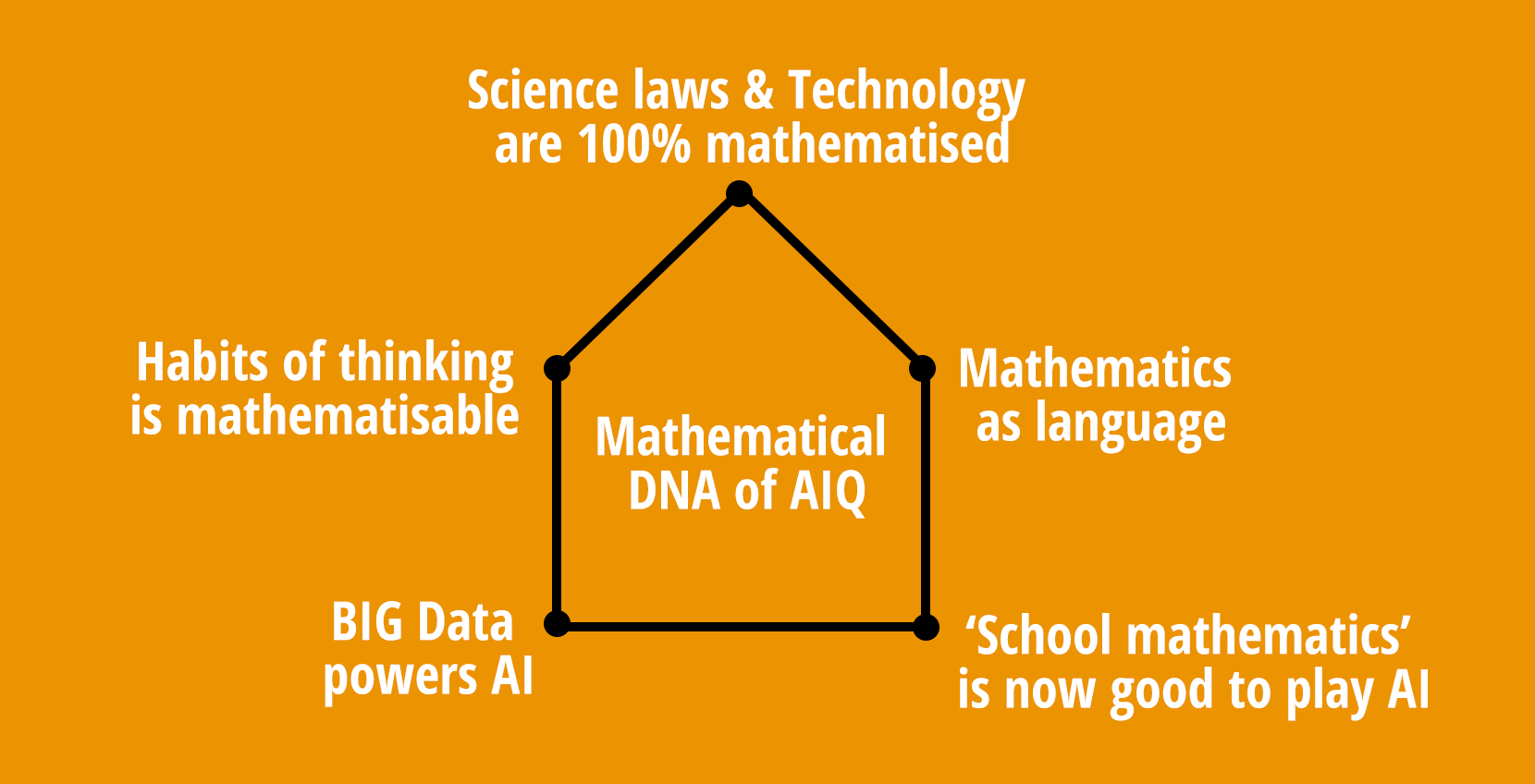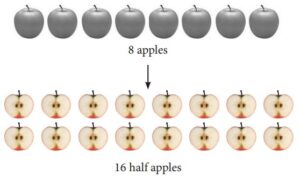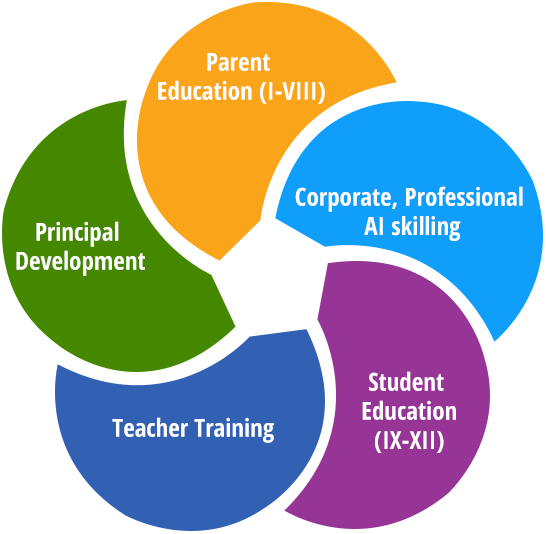
AIQ, the new capital, is mathematical


How AIQ is mathematical

How we reorganised ‘school mathematics’

How we enhance AIQ


Experience the human revolution, NOW

Download
Learn 'A - Z' of Mathematics and AI basics, reinvent self!
First,
learn the 500+ missing 'micro concepts and logic’ and how AI thinks mathematics.
Second,
mathematise your habits of thinking.
Be a leader at work and at home.

Humankind is mathematising
THE INORGANIC MOMENTUM

The inorganic momentum
The 4IR technologies are similar to their 3IR roots. However, their extra thrust lies elsewhere – more science (new and refined) and more rapid innovations (shorter ‘Technology Cycle Time’). In a way, 4IR is a ‘general purpose (sci-tech) ecosystem’, so vastly expansive that it will underpin infinite ‘plug and play’ choices for people. The ‘general purposeness’ emerges out of the digital technologies getting ‘softer’ by the day as the hardware is getting literally and figuratively miniaturised.
In turn, the softwarisation of digital technology is limited only by our ability to logicalise situations and logicalisation is actually mathematisation, our ability to express given situations through mathematical expressions.
By definition, new applications of digital technologies often follow mathematical discoveries. Infinitisation of 4IR is limited only by the mathematisation of (our) thinking – for both the halves of 4IR – technological innovations, as well as people capacity building.
Mathematisation of thinking is just the imperative.
THE ORGANIC MOMENTUM

The organic momentum
Big Data is one driver of the mathematisation, leading to revolutionary changes in the discovery of science, invention of technology, and the process of innovation and research. This avatar of mathematics is a showcase example of how mathematics is the only language for capturing order, patterns, or definitiveness. The other is the very nature of mathematics, the fact that it is already a big part of our everyday living (we use deductive logic all time) and its high-impact applications do not demand high-end mathematics (Calculus is not at the heart of Big Data analytics, it is essentially the ‘simpler’ Linear Algebra.)
Mathematics is also gaining ground in social sciences, and even biology. In fact, ‘bio-math’ may just be the most cutting edge of research for the couple of decades ahead. The more we know biology, the more mathematisation it undergoes to be able to express the definitiveness of the discoveries.
Above all, the much wanted reform in the education system is waiting for achieving success for all students in mathematics!
Peerless significance of mathematics education
The institutional readiness is grossly underevaluated

The institutional readiness is grossly underevaluated
I can write a whole volume on the unique and multi-dimensional role mathematics and mathematics education plays in school years. To the point, success in mathematics is the best condition for a happy childhood, nursing critical and creative thinking like nothing else; a happy child (and interested adults around) is the best learner.
The accompanying picture lists just a few.
THE CATALYTIC GAINS OF ACTUALISING THE SUCCESS

The catalytic gains of actualising the success
Language and learning are organically related, thinking through words is infinitely powerful (compared to the other mode- using images); more powerful the language the better the learning. Mathematics must be learnt as a language, it is the language through which physics is ‘observed, captured, communicated, and concatenated.’ It is the language of the most real of the worlds there is, what is more real, common, and dynamic as the nature we study through the lense of forces.
Mastering mathematics to (uniquely) express real-life situations is an intellectual feat. Fortunately, EVERYONE is born to excel in mathematics (the ‘school curricula’ level foundational mathematics.)
Welcome to Cent Percent Mathematics
Welcome to the beautiful world of ‘real mathematics’!

Welcome to the beautiful world of ‘real mathematics’!
I have volumes written on ‘real mathematics’ – the universal language of the real world. Unsurprisingly, and it is humbling to realise the fact it is simpler than the simplest of all the natural languages – the shortest set of ‘alphabets,’ ‘grammar rules’ are all logical and no more than a score of conventions, etc.
Briefly, the accompanying picture lists just a few manifestations of the simplicity of mathematical knowledge (if duly discovered, not what school systems call mathematics.)
We call the ‘real (curricular) mathematics’ as ‘Cent Percent Mathematics.’
The world would have already been a wildly different place if 200 years of the current school education system had gotten mathematics education to work for every student.
A robust math education dramatically trains us to think better – think in a more reasoned, logical, ordered (systematic), and in a more confident way. Nothing trains us to naturally think about the ‘why’ of everything as does good math education. Persistent and organically connected ‘whys’ have a distinguishing destination – right thinking (reasoning). It is only apt to quote Jordan S Ellenberg, a mathematician who is also a fiction and non-fiction author, ‘Math trained habits of thought … how not to be Wrong.’
A good education in math instils the natural habit of thinking, reasoning and seeking a deeper understanding of all numerically expressible situations. It helps us translate real-world situations/relationships/events into mathematical expressions (models) on paper!
Needless to say, school math strips math education of all shades of mathematical thinking. Mathematical thinking is not about arithmetic or algebraic equations, it is about training the mind to think more logically, reason better, and see patterns in the behaviours of numerically definable situations/events/relationships. Of the two – improving the content of thinking and improving the process of thinking – the latter takes far less effort to acquire, and it is a very generic ability.
For example, Algebra brings in the sense of transparency and truthfulness – two important moral strands at a societal level. Algebra rests on the public and precise quantification of relationships. Expressed as equalities, or inequalities algebra promotes appreciation of the connectedness of things.
Cent Percent Mathematics – The human mathematics

Cent Percent Mathematics – The human mathematics
‘Visualising and Verbalising’ K-12 mathematics, named Cent Percent Mathematics, is set to unbound the promise and possibilities of AI and 4IR (The Fourth Industrial Revolution). Cent Percent Mathematics draws on our innate gift of imagination that is expressed in a language (that is why reading is so powerful and individualised). Here are a few simple examples of ‘Visualised and Verbalised’ real-world situations that are mathematically correct if we (just) follow our (logical) instincts.
Let us recall how children learn addition, for example, how ‘3 + 5 = 8’. No one has to know addition to tell how so, they simply visualise 3 things and 5 (similar) things and find the total count of it to be 8 things. Indeed, the only way to know the sum of ‘3 + 5’ is to count the final quantity, and we all know that; school math takes the abstract route of memorising, methodising ‘3 + 5’.
The idea of operations is in us already. Let us evaluate if obtaining the quantity represented by 2/(1/2) is intuitive and that the idea of division does not require any teaching/inputs.
There is no special (mathematical) knowledge needed to find the quantity of half apples in eight full apples (except of course the number system being used to express the quantity). It is visualisable by one and all that there be sixteen half apples would be obtained from eight apples; it is as easy as imagining each of the eight apples being cut into half and that count of half apples being sixteen. Pictorially,

Half apples in 8 apples
The idea of the operation is so sharp in us all that the difference between 2 × 5, and 5 × 2 is almost missing in school, globally (both are taken to be just 10, totally similar mathematical statements). However, ask anyone if the following two situations are similar, and the resounding response will be ‘No’. The following pictures make it evident:


The challenging idea of percentage is commonsensical too. The percentage is a relationship of quantities, it defines a relationship in terms of 100, for example, if for every 100, the relevant quantity is 50 then we call such a relationship as 50 per cent. Then, for every 1000 we would have 500 (500 is 50 per cent of 1000).
Commonsensically, all of us know that if for every 1 we have 2, then for 50 we have 100; if for every 1 we get 1/2 then for every 100, we get 50.
Mass-scaling Cent Percent Mathematics education
The organic strategy

The organic strategy
This section is duly elaborated on The FL@T Project page. Cent Percent Mathematics is the catalyst for the swiftest human revolution – necessary academic credentials amongst all adults (and the students in schools) to secure economic dignity in the most sci-tech of times ahead. It is about ‘same-outcome’ academic education renaissance on the back of assured success in learning pre-data-science, Grades K-10+ curricular mathematics.
The K-12 education system, globally, is acting like a toddler, acting defiantly in certain ways; rightfully so, K-12 is just under 200 years old to humanity, the newest significant social institution. Edtech emerged as the killer pathway to emancipate education system from the clutches of the entrenched interests, or even plain ignorance. Edtech, as is, has been miserably failing in its goals, and it has no future as long as it is read and meant as ‘Technology IN education.’
Edtech has to come to mean ‘Technology OF education,’ placing education at the centre of it all, not technology per se (such as IT.) Education is about ‘making men’ and it is almost entirely a social process, including adults who are academic experts and initiate, nurture and sustain conversations. There is little role of technology in education of children to grow to be ‘(economically) dignified and cultured adults.’ Pertinently, mathematics is no exception, the best mathematics education does not need ‘games, labs, computer games, specific objects, etc.’; mathematics is as real as the natural languages.
Naturally, word-of-mouth is the best means of promoting educational products and services. Cent Percent Mathematics will grow through people conversations, recommendations, handholding, and being the object of gift.
The inorganic strategy

The inorganic strategy
Much more is needed when products and services have to cross cultural and language boundaries. Mathematics is a language, and the ‘law of languages’ operate here too –
The only pre-requisite for learning math – natural language
Surprise it may, if only we can precisely express a situation in a natural language, we can easily translate it into a mathematical expression. Talking of learning languages, we learn a language on the back of another we already know. A second language is learnt on the back of parallels with the first, and a third on the back of its similarity with the first and the second. And how do we begin the journey of learning the very first natural language? The language of art, music, gestures, etc. is a gift to all children, we use these for learning the first natural language. For example, we learn to differentiate between the cups and glasses, how-so-ever imaginatively crafted, by visualising the cups and glasses already seen physically, or in pictures.
This also implies that several million new-age mathematics tutors would have to be developed to reach far beyond the national languages. We would also create a parallel institutional identity and processes for learning mathematics, through an ‘online mathematics school’.
The FL@T Project page presents the broader, detailed framework for mass-scaling Cent Percent Mathematics.
FAQs
Understanding Mathematical Thinking
Demathematised Mathematics Hundreds of missing mathematical logic
Why mathematics education may be humankind’s biggest unresolved challenge?
Why ‘Cent Percent Mathematics’?
Mathematics as a language
Mathematics - the simplest language

